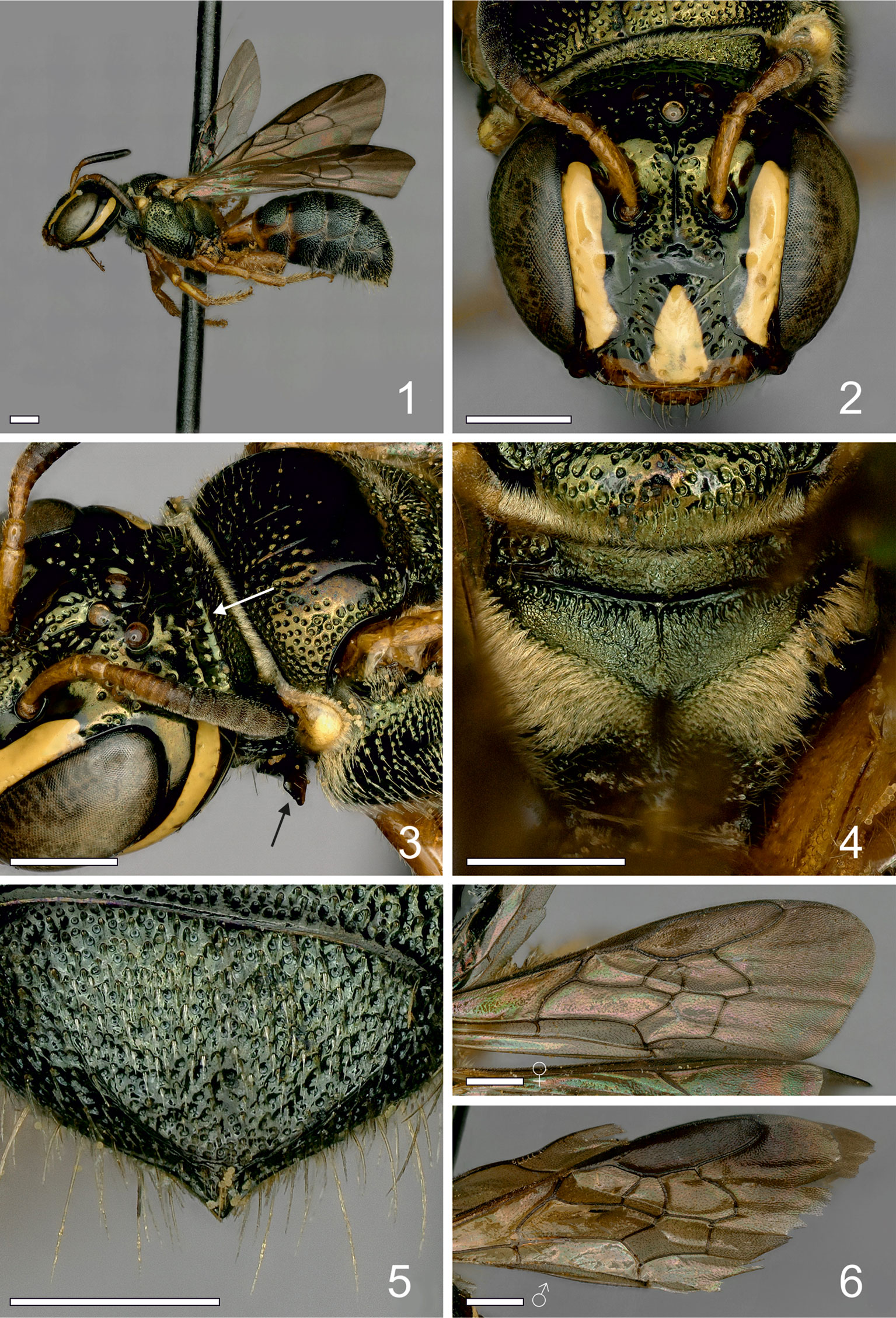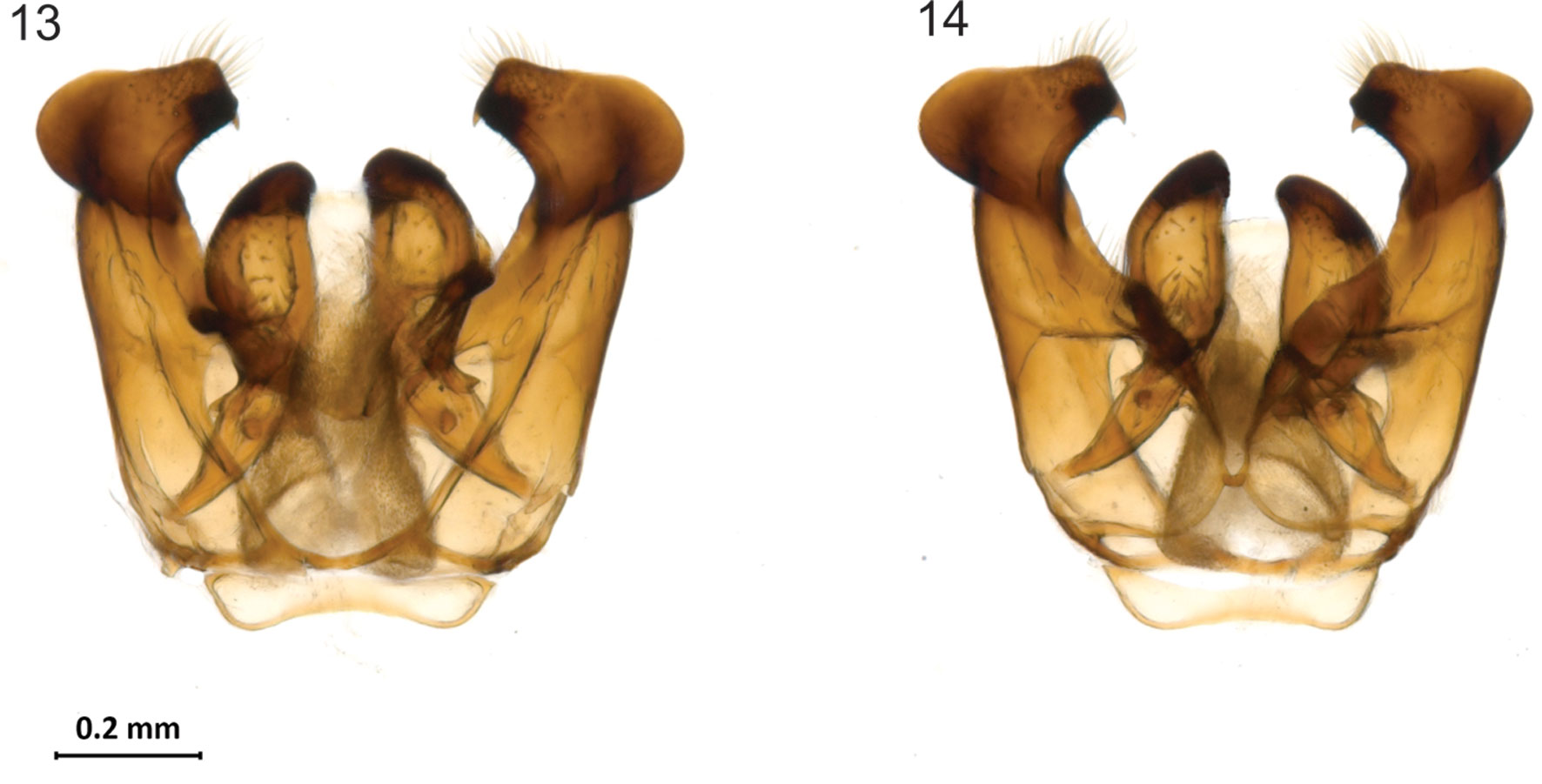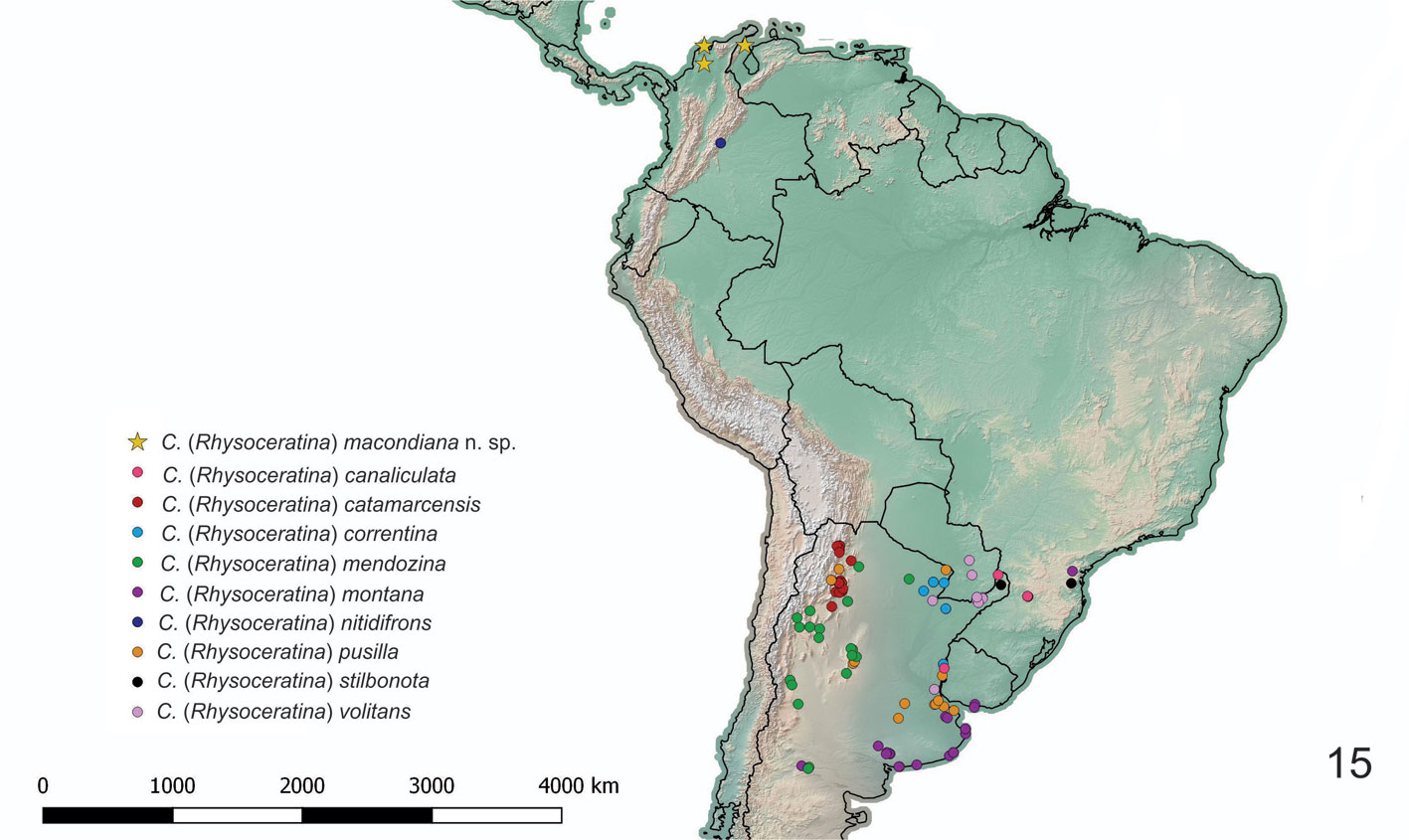A new bee species of the subgenus Ceratina (Rhysoceratina) (Hymenoptera: Apidae) from northernmost South America
Nathalia A. Flórez-Gómez a, *, Terry Griswold b
a Instituto de Biología, Universidad Nacional Autónoma de México, Apartado postal 70-399, 04510 Ciudad de México, Mexico
b USDA-ARS Pollinating Insects Research Unit, Utah State University, Logan, Utah 84322-5310, USA
*Corresponding author: naflorezg@gmail.com (N. Flórez-Gómez)
Received: 17 May 2019; accepted: 21 February 2020
http://zoobank.org /urn:lsid:zoobank.org:pub:1926ADE1-6D4A-43C3-8360-C27E96D6F54C
Abstract
The subgenus Ceratina (Rhysoceratina) Michener has been known largely from southern South America, registered in Argentina, Paraguay, Uruguay and southern Brazil, with a single species, C. (Rhysoceratina) nitidifrons, from the Eastern Llanos of Colombia. Here we describe and illustrate females and males of a new species, Ceratina (Rhysoceratina) macondiana sp. nov. It is apparently endemic to the Caribbean Region of Colombia and Venezuela, extending the distribution range of Rhysoceratina to the extreme north of South America. Ceratina macondiana sp. nov. is easily separable from other Rhysoceratina species in both sexes by the color of the marginal cell, which is darker than the rest of the forewing and the dense white hairs on the lateral sides of the propodeum and posterior ridge of the scutellum.
Keywords: Bee; Small carpenter bee; Apoidea; Xylocopinae; Ceratinini
© 2020 Universidad Nacional Autónoma de México, Instituto de Biología. This is an open access article under the CC BY-NC-ND license
Nueva especie del subgénero Ceratina (Rhysoceratina) (Hymenoptera: Apidae) para el norte de Sudamérica
Resumen
El subgénero Ceratina (Rhysoceratina) Michener ha sido reconocido principalmente para el sur de Sudamérica en Argentina, Paraguay, Uruguay y sur de Brasil y con una sola especie, C. (Rhysoceratina) nitidifrons, descrita para los Llanos Orientales en Colombia. En el presente trabajo se describen e ilustran hembra y macho de la especie nueva, Ceratina (Rhysoceratina) macondiana sp. nov. Hasta el momento, se registra únicamente para la región Caribe de Colombia y Venezuela, extendiendo el rango de distribución del subgénero al norte de Sudamérica. Ceratina macondiana sp. nov. se diferencia fácilmente de las otras especies del subgénero porque ambos sexos presentan la celda marginal más oscura que el resto del ala, además presentan pilosidad densa y blanquecina en las partes laterales del propodeo y en el margen posterior del escutelo.
Palabras clave: Abeja; Pequeñas abejas carpinteras; Apoidea; Xylocopinae; Ceratinini
© 2020 Universidad Nacional Autónoma de México, Instituto de Biología. Este es un artículo Open Access bajo la licencia CC BY-NC-ND
Introduction
Small carpenter bees of the genus Ceratina Latreille comprise one of the most diverse and widespread genera of bees in the world. Five of the 21 subgenera currently recognized by Michener (2007) are native to the Americas: Zadontomerus Ashmead, diverse and widely distributed in temperate North America with some species in Central America and extending to northern South America; Calloceratina Cockerell and Crewella Cockerell, neotropical subgenera with distributions from southern Mexico to Argentina; Ceratinula Moure with few species in North America and most diverse in Central and South America, and Rhysoceratina Michener in South America from Colombia to Argentina, being more diverse in Argentina. Roig-Alsina (2013) added 1 South American subgenus, C. (Neoclavicera) Roig-Alsina that occurs from Peru to Argentina.
Revisionary work on Western Hemisphere Ceratina is limited. While nearctic species of Ceratina from the USA and Canada have been revised, there is no comprehensive revision of neotropical Ceratina (Daly, 1973). However, 2 neotropical subgenera, Neoclavicera (Roig-Alsina, 2013) and Rhysoceratina (Roig-Alsina, 2016) were recently revised. All but 1 of the 9 previously recognized Rhysoceratina species are found in the southern half of South America, mostly in Argentina and southern Brazil, with some species in Uruguay and Paraguay. The other species is a disjunct species in Colombia, C. (R.) nitidifrons Roig-Alsina, occurring in eastern Colombian Llanos in Villavicencio, Meta. Here we describe a new species of C. (Rhysoceratina) from the Caribbean region of Colombia and Venezuela, extending the distribution range of Rhysoceratina to the extreme north of South America.
The subgenus Rhysoceratina consists of small-sized bees (4.8-8.5 mm long), with weakly metallic integument and yellow marks in the paraocular area, clypeus, pronotal lobe and legs. Most of the species have extensive punctation. The subgenus is easily recognized in the female by a strong, transverse carina on T6 and by the wax plate restricted to S2. Males have a medial marginal projection on T7 (Roig-Alsina, 2016).
Materials and methods
Morphological terminology follows that proposed by Michener (2007). Abbreviations used in the descriptions are T, S, and OD for metasomal terga, metasomal sterna and ocellar diameter, respectively. Bee specimens were examined and measured using a Leica MZ12 dissection microscope with ocular micrometer. The illustrations were taken using a Keyence and a Leica Z16 APO to illustrate male genital capsules. The distribution map of South America was generated with QGIS 2.18.24, using the geographic data taken from labels of examined specimens and the localities referenced in Roig-Alsina (2016). Type specimens are deposited in the USDA-ARS Pollinating Insects Research Unit, Utah State University (BBSL).
Description
Ceratina (Rhysoceratina) macondiana Flórez-Gómez & Griswold, sp. nov.
(Figs. 1-13)
http://zoobank.org/urn:lsid:zoobank.org:act:ADC82443-
67C4-456B-A95C-E0CDB13453B7
Diagnosis. This species is easily separable from all other Rhysoceratina species in both sexes by the color of the marginal cell, which is darker than the rest of the forewing, and by the dense white hairs on the lateral sides of the propodeum and posterior ridge of the scutellum. It differs from C. nitidifrons by the longer paraocular marks which reach above the antennal socket, the velvety pubescence dorsolaterally on the propodeum, the lamellate lateral carina of the pronotum, and in the female by the lateral projection of the forecoxa not directed posteriorly.
Female. Length 7.7 mm: length of forewing 6.1 mm. Color. Black with dark olive green metallic tints. Scape, pedicel and first flagelomeres reddish brown. Apical tarsomeres brown. Tegula light brown to golden, translucent. Yellow paraocular marks reaching above antennal socket, clypeus with triangular longitudinal yellow mark reaching upper margin. Gena with long longitudinal yellow mark reaching preoccipital ridge. Pronotal lobe with yellow spot. Legs, except coxae, orange. Foretibia with longitudinal yellow band, forefemur with apical yellow spot. Wings brownish, forewing with marginal cell distinctively darker than the rest of wing (Fig. 6). T1 orange.
Structure. Preoccipital ridge carinate. Circumantennal area slightly depressed. Pronotum with lamellate lateral carina, in frontal view carina compressed when it reaches dorsolateral angle; dorsolateral angle rounded. Axilla laterally projecting, rounded. Forecoxa with lateral projection truncate apically, not projecting posteriorly. T6 with transverse apical carina (Fig. 5) (diagnostic of the subgenus Rhysoceratina). S2 with basal wax plate. OD 0.14 mm.


Punctation. Paraocular area, gena polished, impunctate. Small area above antennal sockets impunctate, area near central ocelli and vertex with small punctures separated by distance equal to diameter of punctures or more. Area above lateral ocelli polished, impunctate. Area between antennal sockets with small, dense punctation. Mesepisternum with small, dense punctures, separated by less than diameter of punctures, except small impunctate region on hipoepimeral area. Scutum with disc impunctate, area between admedian line and notaulus with small, dense punctures. T1 polished, impunctate, with sparse punctation on medial area. T2-T3 with small, dense punctation except for transverse impunctate area.
Pubescence. Scarce, dispersed white pubescence, except dense on lateral sides of propodeum (appears golden in lateral view), posterior ridge of scutellum (Fig. 4). Sterna with sparse, but distinct, short apical pubescent bands.
Male. Length 7.3 mm; length of forewing 5.7 mm. Color. Similar to female except: paraocular marks long, yellow as in female, but broader. Clypeus with T-shaped yellow mark reaching upper margin. Labrum with yellow mark. Mandible with yellow spot medially. Pronotal lobe with yellow spot. Lateral projection of the forecoxa yellowish (Fig. 9). Foretibia with yellow stripe. Forefemur with yellow spot apically. Tarsi yellowish. Wings brownish, forewing with marginal cell distinctively darker than rest of wing (Fig. 6).
Structure. T6 with median projection with apical short hairs (Figs. 11, 12). T7 with apical margin flanged, with low medial lobe. OD 0.14 mm. Genital capsule, gonostylus with the lateral margin rounded and projected and hairs in the apical margin (Figs. 13, 14).
Punctation. Similar to that of female.
Pubescence. Hind trochanter, basal third of hind femur in ventral view with short, dense pubescence (Fig. 10). Propodeum, posterior ridge of scutellum with dense pubescence laterally.
Taxonomic summary
Etymology. The specific name refers to Macondo, the fictional town from Gabriel García Márquez’s novel “Cien años de soledad”. Macondo represents towns from the Colombian Caribbean.
Distribution. Known only from northern Colombia (Atlántico, Barranquilla. Bolivar, Zambrano) and Venezuela (Zulia, Carrasquero).
Type material. Holotype: Colombia 1 ♀; Atlántico, Barranquilla, 5 Oct 1971, 235 m, GE Bohart, (BBSL). Paratypes: Colombia, 3 ♂, 1♀, same data as for holotype (BBSL); Venezuela, 1♂, Zulia: Carrasquero, 15 Jun 1976, AS Menke et D Vincent (BBSL).
Discussion
Although Ceratina is a diverse genus in the Neotropics, few species are known from northern South America (Moure, 2012). Only 7 species are recorded from Colombia and Venezuela: 3 of the subgenus C. (Ceratinula), 2 of C. (Crewella) and of C. (Calloceratina), and 2 of C. (Rhysoceratina) including C. macondiana sp. nov. This is the first record of C. (Rhysoceratina) for Venezuela. Moreover, C. macondiana sp. nov. extends the distribution of the subgenus to the extreme north of South America. Based on the current records for the species of this subgenus, C. macondiana sp. nov. and C. nitidifrons have a disjunct distribution from the rest of C. (Rhysoceratina) species (Fig. 15).


Acknowledgements
To Chelsey Ritner for providing the images for this study. We thank Conacyt-Mexico mobility scholarship award for granting the visit to BBSL and Ricardo Ayala for the observations on the manuscript.
References
Daly, H. (1973). Bees of the genus Ceratina in America north of Mexico (Hymenoptera: Apoidea). University of California Publications in Entomology. Berkeley: University of California Press. 74.
Michener, C. D. (2007). The bees of the World. Second Edition. Baltimore: The Johns Hopkins University Press.
Moure, J. S. (2012). Catalogue of bees (Hymenoptera, Apoidea) in the Neotropical Region – online version. Xylocopini Latreille, 1802. Available: http://moure.cria.org.br/catalogue?id=1
Roig-Alsina, A. (2013). El género Ceratina en la Argentina: revisión del subgénero Neoclavicera subg. n. (Hymenoptera, Apidae, Xylocopinae). Revista del Museo Argentino de Ciencias Naturales, Nueva Serie, 15, 121–143. https://doi.org/10.22179/revmacn.15.174
Roig-Alsina, A. (2016). A revision of the bee genus Ceratina, subgenus Rhysoceratina (Hymenoptera, Apidae, Xylocopinae). Revista del Museo Argentino de Ciencias Naturales, Nueva Serie, 18, 125–146. https://doi.org/10.22179/revmacn.18.473



